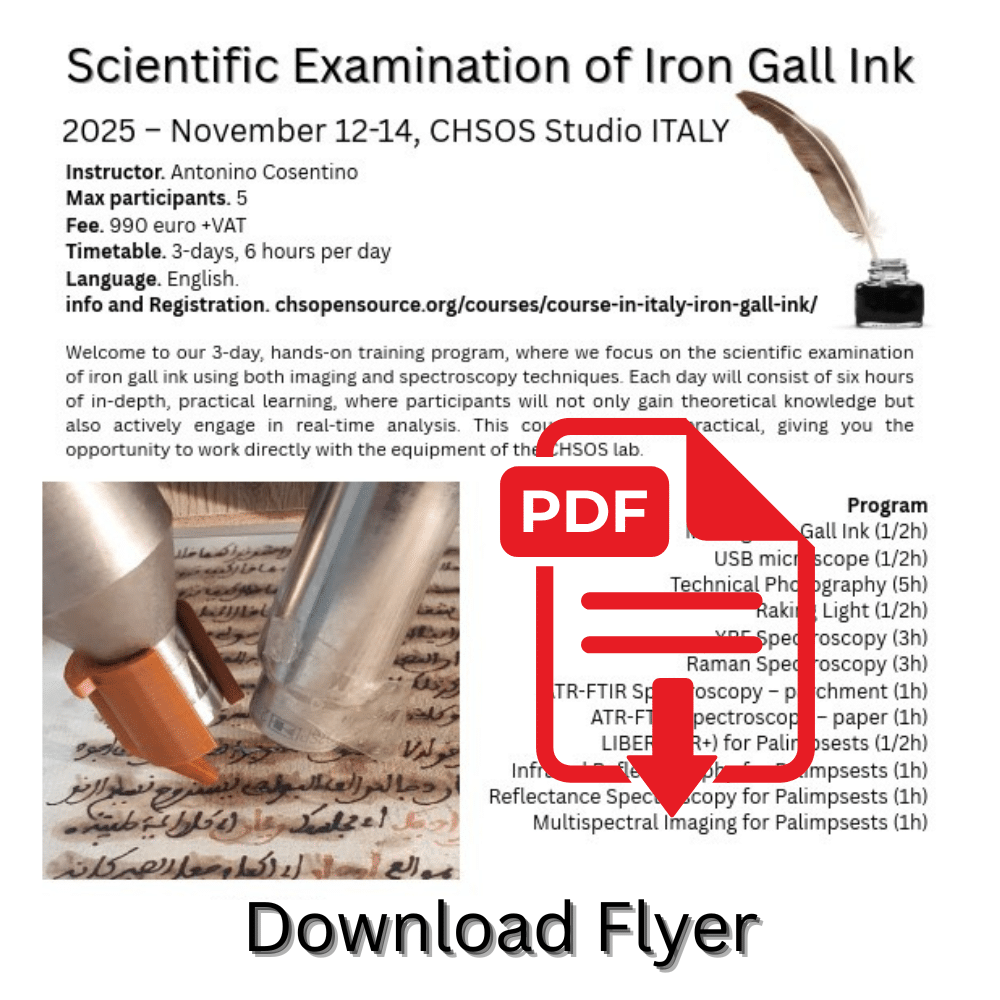Ready to launch new version, Antonello V.2, next week….
Antonello – Multispectral Imaging (MSI) System for Art and Archaeology
Download this page as a pdf Multispectral Imaging System - Antonello
In Brief
Conservators and art historians need non-invasive methodologies to identify and map pigments on works of art and archaeology. These tools allow them to select appropriate conservation procedures, acquire information on the workshop practices, distinguish original sections from inpaints and to enhance visualization of faded pigments and inks.
Antonello is our simple MSI system composed of 18 bandpass filters and a digital camera, covering the 400-925 nm spectral range. Using a digital camera rather than a monochromatic scientific dedicated camera has the advantage that the same camera can be used for other technical photographic methods, making the overall imaging equipment lighter, compact and affordable.
We developed Antonello to spread the use of this methodology across Art Conservation professionals and institutions. Antonello, our low-cost MSI system for Art and Archaeology uses specifically designed in-scene gray reference targets and it is versatile and adaptable to the specific needs of different art or archaeology examination projects, such as manuscripts, wall paintings, and easel paintings.
We developed Antonello to be: user-friendly, compact and lightweight, easy to understand, tune-up and upgrade.
[insert page=’multispectral-imaging-msi’ display=’content’]
Our Catalog and Prices - PDF
Software is simple and just need to follow step-by-step instructions.





The filters set
The system is composed of 18 bandpass filters whose labels clearly indicate their center wavelengths and their order number. This is the list of filters (center wavelength (nm)): 405, 430, 450, 467, 480, 500, 532, 560, 580, 610, 640, 671, 700, 730, 760, 840, 860, 920. The 18 filters are not equally spaced but have the same bandwidth (10 nm). The center wavelengths of these filters have been chosen in order to better represent the spectral features of historical pigments and they correspond to specific absorption or inflection points.
Whites. Titanium white has a strong UV absorption band (filter at 405 nm) that goes until the violet region and distinguishes it from the other white pigments. Lithopone features the absorption bands (filters at 670 nm and 725 nm) in the red- infrared region due to its zinc sulfide component [22].
Blues. Prussian blue and cobalt violet have maxima in the blue region (respectively, filters at 450 nm and 700 nm). Maya blue and indigo have inflection points in the infrared (respectively, filters at 760 nm and 840 nm).
Smalt features a maximum in the blue region (filter at 430 nm) and a large absorption band in the yellow region (filter at 580 nm). Phthalo blue has a maximum in the blue region (filter at 465 nm) and an absorption band in the infrared (filter at 920 nm). Cobalt blue features an inflection point in the green region (filter at 525 nm). Azurite and ultramarine large maxima in the blue region are covered by all the 5 filters already mentioned from 405 nm to 480 nm.
Greens. Malachite, verdigris and phthalo green have their maxima in the green region (respectively filters at 525 nm and 500 nm). Viridian has its inflection point in the infrared (filter at 760 nm). Green earth has weak absorption bands which cannot be resolved with this system and consequently it will produce a flat spectrum. Cadmium green is identified by its infrared fluorescence and no filter was selected for its spectral features. Cobalt green maximum is represented by the filter at 532 nm. The filter at 405 nm outlines the chrome green maximum in the violet region.
Yellows. Cadmium yellow has its sharp inflection point in the blue-green region (filter at 480 nm) while cobalt yellow has a week absorption band in the red region (filter at 610 nm). Orpiment and saffron have their inflection point outlined by the filter at 532 nm. Lead tin yellow I has a sharp inflection point covered by the filter at 467 nm. Lead tin yellow II, naples yellow and gamboge inflection points are represented by the filter at 532 nm. Yellow and red ochre as well as sienna show an S-shape spectral feature with maxima at 600 nm and 770 nm and minima at 645 nm, 860 nm and 915 nm (respectively filters at 610 nm, 760 nm, 640 nm and 920 nm). Massicot has an inflection point at 450 nm (filter at 450 nm) and yellow lake reseda at 490 nm (filter at 500 nm). Realgar has its inflection point at 560 nm and a filter was added to cover it.
Reds. Vermilion, cadmium red, alizarin and madder lake have inflection points at 600 nm (filter at 610 nm). Lac dye spectrum is heavily dependent on the binders with an inflection point varying widely and so no specific filter was added for it. Carmine lake has an inflection at 630 nm (filter at 640 nm). Red lead has its inflection point at 575 nm (filter at 580 nm).
Browns and black. They don’t have spectral features useful for their identification.
| center (nm) | notes |
| 405 | Titanium white absorption; chrome green maximum |
| 430 | Smalt, malachite maxima |
| 450 | Prussian blue maximum, massicot inflection |
| 467 | Phthalo blue maximum (465), lead tin yellow I (465) inflection |
| 480 | Cadmium yellow inflection |
| 500 | Verdigris, phthalo green maxima; yellow lake R. (490) inflection |
| 532 | Cobalt blue inflection; cobalt green maximum; orpiment, lead tin yellow II (525), naples yellow (515), gamboge (535) and saffron inflections |
| 560 | Realgar inflection |
| 580 | Red lead (575) inflection |
| 610 | Cobalt yellow absorption (615); ochre (600) maxima, vermilion, cadmium red, alizarin, madder lake inflection |
| 640 | Ochre (645) minimum; carmine lake (630) inflection |
| 671 | Lithopone absorption (670) |
| 700 | Cobalt violet maximum |
| 730 | Lithopone absorption (725) |
| 760 | Maya blue, viridian (770) inflections; ochre (770) maximum |
| 840 | Indigo inflection (830) |
| 860 | Ochre minimum |
| 920 | Phthalo blue, ochre (915) minima |
TP and MSI calibration card
We cannot use commercial gray cards for photography with Antonello since they absorb near UV and violet radiation and cannot be used for the filter at 405 nm. The MSI calibration card covers the 400-925 nm spectral range. It has 6 swatches, pure white, 4 grays and pure black. Learn more on our Technical Photography and MSI calibration card.

Splitting raw images
The photosensors of each pixel of a digital camera cannot distinguish the wavelength of the incoming light. Tiny color filters cover the pixels to select only red green or blue light (RGB). The on-camera processor converts the raw image to a full-color image using a demosaicing algorithm. We cannot use this image to reconstruct correct reflectance spectra since the demosaicing algorithm introduces arbitrary interpolation. Antonello splits the raw images into their RGB native components without any interpolation.

Registration
Registration is the operation of aligning and scaling in order to make all the images overlap to each other. We register the 18 spectral images ataking the first spectral image as a reference for all the others (differently than progressive methods which register one image to the previous).
Our Research on Multispectral Imaging
| Publications on Multispectral Imaging |
|---|
| A. Cosentino “Imaging Multispettrale low-cost con filtri interferenziali” Archeomatica, 2, 12-17, 2015.. |
| A. Cosentino “Multispectral imaging and the art expert” Spectroscopy Europe, 27 (2) 6-9, 2015. |
| A. Cosentino “Multispectral Imaging of Pigments with a digital camera and 12 interferential filters” e-Preservation Science, 12, 1-7, 2015.. |
| A. Cosentino “Panoramic, Macro and Micro Multispectral Imaging: An Affordable System for Mapping Pigments on Artworks” Journal of Conservation and Museum Studies, 13(1): 6, 1–17, 2015 |
| A. Cosentino “Multispectral imaging system using 12 interference filters for mapping pigments” Conservar Património 21, 25-38, 2015. |
| A. Cosentino “Crowd funded research: low-cost multispectral imaging” RECH3, International meeting on Retouching of cultural heritage. 2015. |
| A. Cosentino “Transmittance spectroscopy and transmitted multispectral imaging to map covered paints” Conservar Património 24, 37-45, 2016. |
FAQ
Does it only work with that particular camera or with any model?
Yes, Antonello works with any digital camera modified to cover the 360-1000 nm spectral range. We suggest 2 Nikon cameras, but Antonello can be used with any other model. You can use Antonello (filters set and software) with the modified digital camera that you already have and use for infrared photography and / or UV photography. No need to buy a new one.
Does the software only work with this particular filter set and camera?
No, the software can be adapted to different filters set and cameras, as well as develop your own workflow.
Are there also bigger filters? Aren’t the images heavily cropped when putting small filters (1 inch, 25 mm?) in front of larger (52 mm) lenses?
Yes, there are bigger filters but they are much expensive. 1 inch is the standard diameter these kind of scientific filters are produced, so their cost is relatively low. But larger filters must be custom-made so they become much more costly. So, in order to be a relatively lost cost system, Antonello uses 1-inch filters associated with a long focal lens, we suggest 105 mm. This reduces considerable vignetting even using this small filter size.







